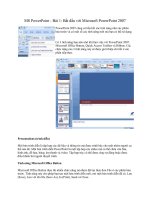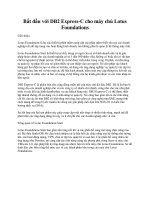Bắt đầu với Sping - introduction
Bạn đang xem bản rút gọn của tài liệu. Xem và tải ngay bản đầy đủ của tài liệu tại đây (184.4 KB, 4 trang )
xix
Introduction
T
he Spring framework is a stunningly good piece of software. Building enterprise software is
a difficult exercise at the best of times, and there are numerous common problems that
developers consistently encounter. Spring smooths over or eliminates a remarkable number
of these problems.
Spring’s clean design and accommodating approach to existing standards and libraries
has resulted in a spectacular rise in its popularity among Java developers. Spring can be
retrofitted to old projects and is now often used as the foundation for new development. If
you haven’t yet encountered Spring, you probably will do so very soon.
Although Spring is well designed and documented, getting bootstrapped in the basics
of the framework can still be difficult. This book aims to get Java developers up and running
with Spring as quickly as possible by tying the abstract and conceptual discussions to
concrete examples in code.
Who This Book Is For
This book assumes an understanding of the basic Java technologies; you must know the
core Java Standard Edition (JSE) libraries and you should also be reasonably experienced
in working with XML files in order to follow the configuration examples. It will be helpful
if you are already familiar with the Maven build tool, but experience with this is not essential.
You are not expected to have any prior knowledge of Spring. The reader I had in mind
when writing the book is someone who is about to start work on a Spring-based project,
who has just joined a Spring-based project, or who has heard about some of the good things
that Spring has to offer and is contemplating using Spring. This book should help you get
your bearings and get cracking.
You will not need to purchase any commercial software in order to learn or use Spring
because the framework is open source software.
Experienced users of Spring should still find some useful information in the later chapters,
and I think even expert developers may find Chapter 7 on Acegi security helpful.
Minter_685-4FRONT.fm Page xix Wednesday, November 14, 2007 6:22 AM
xx
■
INTRODUCTION
How This Book Is Structured
The first three chapters of this book cover the basic introductory matter. Complete
newcomers to Spring should read these chapters in detail before embarking on any of
the other examples or investigating the code samples.
The rest of the chapters cover the basic components of Spring that most developers will
use regularly. Developers who have already worked with Spring and are looking for more
information on the subject will find these to be of more immediate interest than the first
three introductory chapters. Readers who are familiar with Spring 1.x but not Spring 2
should probably at least skim through Chapter 3 because there are some additions to the
XML configuration syntax in Spring 2.
Expert developers are not really the target of this book, but they may find some items of
interest in the later chapters, particularly Chapter 7 and the appendix. The chapter contents
in more detail are as follows:
• Chapter 1 outlines the basic purpose and architecture of the Spring framework, and
introduces inversion of control (IOC) and aspect-oriented programming (AOP)
techniques. This chapter also provides a whirlwind tour of the basic components
discussed in this book.
• Chapter 2 introduces the sample application. It presents a rationale for the applica-
tion, a simplified specification for it, and walks you through the build process. This
chapter also introduces the Maven 2 build tool.
• Chapter 3 provides a detailed explanation of inversion of control and loose coupling,
and explains why they are such useful techniques. This chapter also explains some
of the core Spring classes and Spring’s XML configuration file syntax.
• Chapter 4 explains how Spring can be used to create interchangeable DAO classes
based on different persistence mechanisms. Complete examples are provided for
plain JDBC-based and Hibernate-based database access.
• Chapter 5 shows how various Spring features can be used to create an application’s
service layer. The use of AOP is explained both in enforcing transaction management
and for other purposes.
• Chapter 6 introduces the use of Spring to build the web tier of an application. The
Spring Model View Controller (Spring MVC) and Spring Web Flow libraries are
explained with examples.
Minter_685-4FRONT.fm Page xx Wednesday, November 14, 2007 6:22 AM
■
INTRODUCTION
xxi
• Chapter 7 introduces Spring Security (also known as Acegi security). The various
filters and other components used in a Spring Security–protected application are
explained. The example demonstrates how to provide authentication, authorization,
and channel security services.
• Chapter 8 shows how Spring can be used to send e-mail, a common task that is
relatively difficult without the advantages of the Spring framework. The examples
demonstrate the use of Spring to send plain text, formatted (HTML) text, and
formatted text with attachments.
• Chapter 9 explains how Spring can be used to make an application’s service layer
remotely accessible over the network. Client and server examples are provided
using various protocols, including remote method invocation (RMI) and SOAP.
• Chapter 10 demonstrates the best ways to unit-test your Spring-based application
code. It demonstrates an approach to unit-testing the DAO classes created in Chapter 4,
explains the use of the EasyMock mock control library, and introduces some of the
Spring mock classes provided to ease your testing.
• The appendix is an installation guide and introduction to the Spring IDE plug-in for
the Eclipse development environment. The support for editing XML files, including
autocompletion features, are explained, as are the various file creation wizards, and
the graphical views and editors for other configuration files.
Downloading the Code
The source code for this book is available from the Apress website (www.apress.com). The
source code is provided as a complete Maven project (see Chapter 2).
Contacting the Author
I strive for accuracy and clarity, but of course I don’t always attain them. If you don’t under-
stand something that I’ve written, you think I’ve made a mistake, or you think I’ve omitted
some important material. please feel free to send a note to me directly at
You can read articles on Spring and Java technologies, including occasional code samples
and useful libraries, on my blog at geeklondon.com.
Minter_685-4FRONT.fm Page xxi Wednesday, November 14, 2007 6:22 AM
Minter_685-4FRONT.fm Page xxii Wednesday, November 14, 2007 6:22 AM









